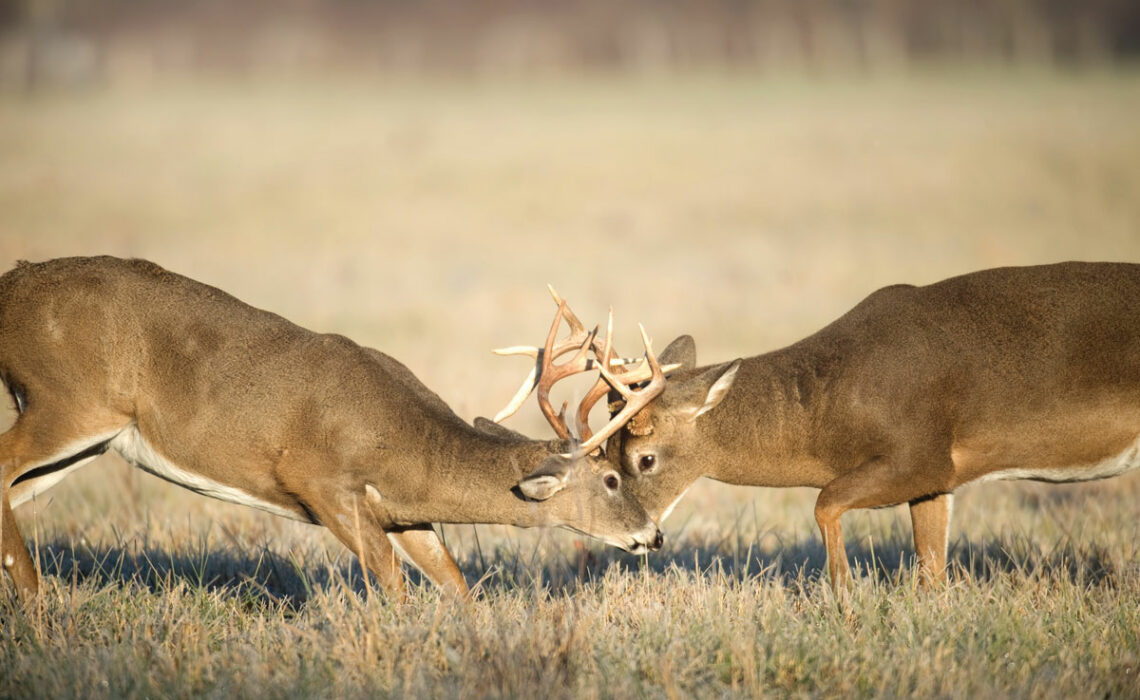
Two bucks lock antlers in a battle to win the heart of a doe during ‘The Rut,’ the mating season for white-tailed deer. In the Highland Lakes, the season runs from Oct. 1 through Dec. 7.
The highest deer-producing region in Texas (that’s us!) is now at the peak of white-tailed deer mating season (November) when passions and hormones wreak havoc in the wild world of Central Texas big game. Biologists and hunters call this time of the year “The Rut.”
“The Rut is the breeding season for deer,” said Texas Parks and Wildlife Department biologist Erin Wehland. “Bucks are capable of breeding for five months, from when they shed the velvet on their antlers until they drop their antlers.”
According to the largest-ever study on deer breeding conducted by the TPWD, the breeding season of deer local to the Highland Lakes runs from late August until late January. Primetime is between Oct. 1 and Dec. 7 with a huge peak in activity around Nov. 7, a weirdly specific date but one that is scientifically proven, Wehland said.
A buck’s most defining feature, its antlers, is an indicator of its readiness to breed, she explained. Antlers begin to grow in the early spring, emerging from two specialized patches on the skull called pedicles. The emerging antlers are coated in a soft velvet skin that is rife with blood vessels capable of pumping insane amounts of nutrients into a buck’s body. Antlers remain “in velvet” for the spring and summer, growing up to an inch and a half per week — the fastest-growing tissue in the mammal kingdom.
As the antlers grow, they are soft and pliable, but when rutting time approaches, they harden beneath the velvet. A buck’s testosterone levels rise as the days grow shorter and its antlers grow harder. By late August, it begins scraping away the velvet, mostly on tree trunks, revealing an impressive set of weapons ready to do battle.
“(A buck’s rutting) behaviors include smelling the air and ground, moving around more, searching, chasing, and defending receptive does,” Wehland said. “They also lack caution.”
Bucks in single-minded pursuit of a mate spend their days and nights tracking down viable does, locking horns with competing bucks, and marking their territory by scraping bark off of trees with their antlers, stomping the ground, and biting foliage. In marking its territory, a buck leaves behind pheromones with its particular smell. Male deers in The Rut forsake sleeping, eating, and self-care in their pursuit of a mate.
Does also take a walk on the wild side, driven by ancient, hormone-fueled instincts timed to facilitate springtime births. On the lookout for the strongest mates, they fight off unsuitable suitors, scour their territories for the perfect match, and leave behind their own pheromone-spiked scents for those deemed worthy to follow.
“Does are in estrus, or receptive to bucks, for only a few days (during rutting),” Wehland said. “If they are not bred, they will cycle and enter estrus again in 28 days.”
Does undergo significant changes. Their hormones kick into high gear, making them receptive to mating but only for short stints based upon the 28-day cycle of the moon. A doe is biologically capable of reproducing for four or five days, but they might only accept a mate within a 24-hour window in that timeframe. A doe is receptive to breeding for only one day a month over the five months of The Rut.
Deer are genetically hardwired to mate during the fall so their young are born in the spring when food is plentiful. White-tailed deer have a 200-day gestation period, meaning a fawn conceived on Nov. 7, the peak of the Highland Lakes rut, will be born around May 25, a time of year guaranteed to have widespread vegetation and at least a little rain. The theoretical newborn fawns do not have to face the freezing temperatures of winter or the blistering heat of summer.
“Fawn survival depends primarily on habitat quality,” according to a TPWD study. “Malnutrition and associated problems are probably responsible for poor fawn survival in much of the state. Dry conditions aggravate the problem of inadequate food. Delayed breeding could cause fawns to be born late, which would be a disadvantage on ranges where food is scarce.”
As winter winds down, bucks and does revert to their typical, timid natures. Does no longer yearn for a strong male in their life and bucks return to eating and hanging out with other males, which they were willing to fight to the death just weeks earlier. Their antlers fall off after mating season, leaving behind chew toys favored by country hounds and collector’s items for veteran hunters and inquisitive kids.
The cycle begins again as spring arrives, reigniting the timeless process of rutting that has driven the persistent existence of white-tailed deer through the ages.












